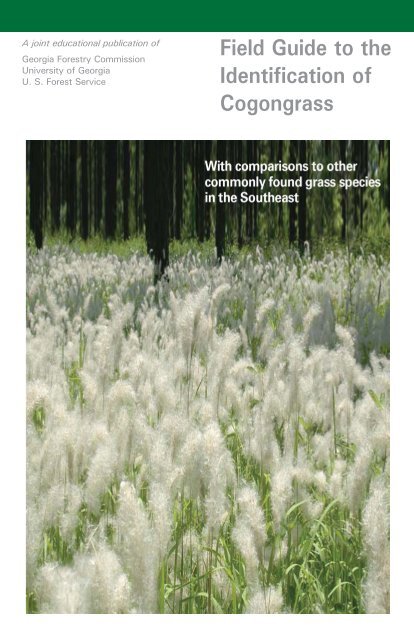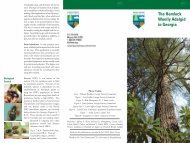Field Guide to the Identification of Cogongrass - Georgia Forestry ...
Field Guide to the Identification of Cogongrass - Georgia Forestry ...
Field Guide to the Identification of Cogongrass - Georgia Forestry ...
Create successful ePaper yourself
Turn your PDF publications into a flip-book with our unique Google optimized e-Paper software.
A joint educational publication <strong>of</strong><br />
<strong>Georgia</strong> <strong>Forestry</strong> Commission<br />
University <strong>of</strong> <strong>Georgia</strong><br />
U. S. Forest Service<br />
<strong>Field</strong> <strong>Guide</strong> <strong>to</strong> <strong>the</strong><br />
<strong>Identification</strong> <strong>of</strong><br />
<strong>Cogongrass</strong><br />
With comparisons <strong>to</strong> o<strong>the</strong>r<br />
commonly found grass species in<br />
<strong>the</strong> Sou<strong>the</strong>ast
<strong>Cogongrass</strong> (Imperata cylindrica) is an aggressive invader <strong>of</strong><br />
natural and disturbed areas throughout <strong>the</strong> Sou<strong>the</strong>ast. It<br />
disrupts ecosystem functions, reduces wildlife habitat, decreases<br />
tree seedling growth and establishment success, and<br />
alters fire regimes and intensity. Recognizing <strong>the</strong> presence <strong>of</strong><br />
cogongrass is necessary before beginning any management<br />
activities. While o<strong>the</strong>r species may look similar, cogongrass<br />
has a unique combination <strong>of</strong> characteristics that make field<br />
identification possible. This field guide describes and illustrates<br />
<strong>the</strong>se characteristics and compares <strong>the</strong>m <strong>to</strong> o<strong>the</strong>r grass<br />
species commonly found in similar habitats. Easy-<strong>to</strong>-understand<br />
terminology is used when possible, and definitions for<br />
technical terms are provided below. <strong>Cogongrass</strong> is a Federal<br />
Noxious Weed and any infestation must be identified<br />
by <strong>the</strong> appropriate state or federal authority. If you think<br />
you have cogongrass on your land, please contact your state<br />
department <strong>of</strong> agriculture or USDA-APHIS <strong>of</strong>fice. For more<br />
information <strong>of</strong> cogongrass ecology and control, visit www.<br />
cogongrass.org.<br />
Scientific Names <strong>of</strong> Compared Species<br />
• Vasey grass (Paspalum urvillei)<br />
• Johnsongrass (Sorghum haplense)<br />
• Silver beardgrass (Bothriochloa laguroides)<br />
• Broomsedge (Andropogon virginicus)<br />
Definitions<br />
Ligule - Small projection at <strong>the</strong> base <strong>of</strong> a leaf blade<br />
Leaf sheath – lower portion <strong>of</strong> <strong>the</strong> leaf which encloses <strong>the</strong> stem<br />
Collar region – junction <strong>of</strong> <strong>the</strong> leaf blade with <strong>the</strong> leaf sheath<br />
Flower/Seed head – entire group <strong>of</strong> flowers or seeds attached <strong>to</strong><br />
flower stalk<br />
Rhizome – Underground stem which <strong>of</strong>ten roots at nodes (<strong>of</strong>ten<br />
thicker and more fleshy than roots)<br />
Citation<br />
Evans, C.W., D.J. Moorhead, C.T. Bargeron, and G.K. Douce. 2008. <strong>Field</strong> <strong>Guide</strong><br />
<strong>to</strong> <strong>the</strong> <strong>Identification</strong> <strong>of</strong> <strong>Cogongrass</strong>: With comparisons <strong>to</strong> o<strong>the</strong>r commonly found<br />
grass species in <strong>the</strong> Sou<strong>the</strong>ast. The University <strong>of</strong> <strong>Georgia</strong> Center for Invasive<br />
Species and Ecosystem Health, Tif<strong>to</strong>n GA, BW-2008-02. 20 p.<br />
1
Key <strong>Identification</strong> Features <strong>of</strong> <strong>Cogongrass</strong><br />
Flower/Seed head<br />
- Cylindrical in shape<br />
- 2-8 inches in length (<strong>to</strong>tal flower or<br />
seed head)<br />
- Silvery white in color<br />
- Light fluffy dandelion-like seeds<br />
- Blooms from late March <strong>to</strong> mid June<br />
(flower timing depends somewhat<br />
on local climate)<br />
C. Evans, UGA<br />
Leaves<br />
- Blades up <strong>to</strong> 6 feet long<br />
- About 1 inch wide<br />
- Whitish, prominent midrib, that is<br />
<strong>of</strong>ten <strong>of</strong>f center<br />
- Margins finely serrate<br />
- Some leaves are very erect, but some<br />
may droop or lie flat<br />
- Often light yellowish-green in color<br />
- Could have a reddish cast in fall/<br />
winter or brown after frost or freeze<br />
C. Evans, UGA M. Atwater<br />
2<br />
C. Evans, UGA<br />
T. Bodner, SWSS
C. Evans, UGA<br />
Key <strong>Identification</strong> Features <strong>of</strong> <strong>Cogongrass</strong><br />
Plant Base<br />
- No apparent stem<br />
- Leaves appear <strong>to</strong> arise directly from<br />
or close <strong>to</strong> <strong>the</strong> ground<br />
- Overlapping sheaths give a rounded<br />
appearance <strong>to</strong> <strong>the</strong> plant base<br />
- All vegetation doesn’t arise from one<br />
dense clump, instead <strong>the</strong> plants are<br />
more spread out<br />
- Light-green <strong>to</strong> yellowish in color, or<br />
could be reddish<br />
- Often a lot <strong>of</strong> thatch around base<br />
Leaf collar/Ligule<br />
- Ligule is a thin-fringed membrane<br />
- Leaf sheaths overlapping, giving <strong>the</strong> plant a round appearance<br />
- Hairy (<strong>the</strong> ligule is <strong>the</strong> most hairy part <strong>of</strong> <strong>the</strong> plant, <strong>the</strong> plant base may<br />
also be somewhat hairy)<br />
3<br />
R. Carter, VSU<br />
J. Miller, USFS<br />
J. Miller, USFS<br />
C. Evans, UGA
Key <strong>Identification</strong> Features <strong>of</strong> <strong>Cogongrass</strong><br />
Rhizome/Roots<br />
- Dense mat<br />
- Many sharp points<br />
- Covered in flaky scales<br />
- Bright white under scales<br />
- Strongly segmented<br />
Whole Plant<br />
- Densely growing patches<br />
- Tall grass (up <strong>to</strong> six feet, averaging 3-4 feet)<br />
- Circular infestations<br />
- Plants <strong>of</strong>ten turn brown in winter (at<br />
least partially, but may depend on<br />
local climate)<br />
C. Evans, UGA<br />
C. Evans, UGA<br />
Rhizomes with scales removed (<strong>to</strong>p)<br />
and intact (bot<strong>to</strong>m)<br />
4<br />
C. Bryson, USDA ARS<br />
C. Evans, UGA<br />
J. Byrd, MSU<br />
J. Lotz, FDOACS
<strong>Cogongrass</strong> Infestation <strong>Identification</strong><br />
Forest - Flowering Forest - Non-flowering<br />
Forest - Dormant Season<br />
C. Evans, UGA<br />
C. Evans, UGA<br />
5<br />
Utility Rights-<strong>of</strong>-way<br />
C. Evans, UGA<br />
D. Moorhead, UGA
<strong>Cogongrass</strong> Infestation <strong>Identification</strong><br />
C. Bryson, USDA ARS<br />
Circular - Flowering Circular - Non-flowering<br />
J. Meeker, USFS<br />
Open Area - Sparse Flowering Open Area - Dense Flowering<br />
C. Bryson, USDA ARS<br />
Roadside - Flowering Roadside - Non-flowering<br />
Aerial View<br />
6<br />
G. Leach<br />
M. Atwater<br />
J. Byrd, MSU<br />
W. Faircloth, USDA ARS
<strong>Cogongrass</strong> - Flower and Seed Head Comparison<br />
C. Evans, UGA<br />
Flower/Seed head<br />
- Cylindrical in shape<br />
- 2-8 inches in length (<strong>to</strong>tal flower or<br />
seed head)<br />
- Silvery white in color<br />
- Light, fluffy dandelion-like seeds<br />
- Blooms from late March <strong>to</strong> mid June<br />
(flower timing depends somewhat<br />
on local climate)<br />
7<br />
C. Evans, UGA C. Evans, UGA
Vasey Grass<br />
Flower/seed head not fluffy, but<br />
loosely branched and spreading.<br />
Broomsedge<br />
Flower/seed head is thin and<br />
sparsely flowered, blooms<br />
late summer.<br />
T. Bodner, SWSS<br />
J. Miller, USFS<br />
8<br />
Silver Beardgrass<br />
Very similar in looks, but <strong>of</strong>ten<br />
somewhat branched and blooms<br />
later in <strong>the</strong> year (June-August).<br />
Johnsongrass<br />
Flower/seed head not-fluffy,<br />
but loosely branched<br />
and spreading.<br />
J. Byrd, MSU<br />
J. Miller, USFS
<strong>Cogongrass</strong> - Leaf Collar and Ligule Comparison<br />
C. Evans, UGA<br />
Leaf collar/Ligule<br />
- Ligule is a thin-fringed membrane<br />
- Leaf sheaths overlapping, giving <strong>the</strong> plant a round appearance<br />
- Hairy (<strong>the</strong> ligule is <strong>the</strong> most hairy part <strong>of</strong> <strong>the</strong> plant, <strong>the</strong> plant base may<br />
also be somewhat hairy)<br />
9<br />
C. Evans, UGA
Vasey Grass<br />
Only membranous ligule is hairy,<br />
leaf collar flared, giving <strong>the</strong> region<br />
a less rounded look.<br />
Broomsedge<br />
Sheath is somewhat hairy, ligule is<br />
covered in numerous long<br />
thin hairs.<br />
C. Evans, UGA<br />
C. Evans, UGA<br />
D. Moorhead, UGA<br />
D. Moorhead, UGA<br />
10<br />
J. Byrd, MSU<br />
Silver Beardgrass<br />
Collar region hairless except for<br />
ligule, which has sparse long hairs.<br />
Johnsongrass<br />
Smooth collar, not hairy except<br />
for a small white hair-patch<br />
behind ligule.<br />
J. Byrd, MSU<br />
C. Evans, UGA<br />
C. Evans, UGA
<strong>Cogongrass</strong> - Leaf Comparison<br />
Leaves<br />
- Blades up <strong>to</strong> 6 feet long<br />
- About 1 inch wide<br />
- Whitish, prominent midrib, that is<br />
<strong>of</strong>ten <strong>of</strong>f-center<br />
- Margins finely serrate<br />
- Some leaves are very erect, but some<br />
may droop or lie flat<br />
- Often light yellowish-green in color<br />
- Could have a reddish cast in fall/<br />
winter or brown after frost or freeze<br />
11<br />
C. Evans, UGA<br />
T. Bodner, SWSS
D. Moorhead, UGA<br />
Vasey Grass<br />
Leaves arise from apparent stem,<br />
and serrations are not as obvious.<br />
Broomsedge<br />
Leaves are thin and <strong>of</strong>ten curled,<br />
and arise from apparent stem.<br />
J. Miller, USFS C. Evans, UGA<br />
D. Moorhead, UGA<br />
D. Moorhead, UGA<br />
12<br />
Silver Beardgrass<br />
Leaves are not serrated and arise<br />
from an apparent stem. Midrib not<br />
as apparent.<br />
Johnsongrass<br />
Leaves wider than cogongrass,<br />
edges are not serrate.<br />
J. Byrd, MSU<br />
C. Evans, UGA<br />
T. Bodner, SWSS
<strong>Cogongrass</strong> - Plant Base Comparison<br />
Plant Base<br />
- No apparent stem<br />
- Leaves appear <strong>to</strong> arise directly from<br />
or close <strong>to</strong> <strong>the</strong> ground<br />
- Overlapping sheaths give a rounded<br />
appearance <strong>to</strong> <strong>the</strong> plant base<br />
- All vegetation doesn’t arise from one<br />
dense clump, instead <strong>the</strong> plants are<br />
more spread out<br />
- Light-green <strong>to</strong> yellowish in color, or<br />
could be reddish<br />
- Often a lot <strong>of</strong> thatch around base<br />
13<br />
R. Carter, VSU<br />
J. Miller, USFS<br />
J. Miller, USFS<br />
C. Evans, UGA
Vasey Grass<br />
Base thick and flattened, <strong>of</strong>ten with<br />
a reddish-purple color. Plant is<br />
very bunched in appearance.<br />
Broomsedge<br />
Plant base has a strongly bunched<br />
appearance, with very apparent<br />
stems.<br />
C. Evans, UGA<br />
D. Moorhead, UGA<br />
14<br />
Silver Beardgrass<br />
Plant base has a strongly bunched<br />
appearance, with apparent stems.<br />
Johnsongrass<br />
Plant base also rounded, but very<br />
thick in comparison <strong>to</strong> cogongrass.<br />
Plant does not appear bunched.<br />
C. Evans, UGA<br />
C. Evans, UGA
<strong>Cogongrass</strong> - Rhizome and Root Comparison<br />
Rhizome/Roots<br />
- Dense mat<br />
- Many sharp points<br />
- Covered in flaky scales<br />
- Bright white under scales<br />
- Strongly segmented<br />
15<br />
C. Evans, UGA<br />
C. Evans, UGA<br />
J. Byrd, MSU<br />
C. Evans, UGA
Vasey Grass<br />
Thin root system, not extensive and<br />
lacking thick, segmented rhizomes.<br />
Broomsedge<br />
Root system fibrous, lacking<br />
rhizomes.<br />
C. Evans, UGA<br />
D. Moorhead, UGA<br />
16<br />
Silver Beardgrass<br />
Root system fibrous, lacking<br />
rhizomes.<br />
Johnsongrass<br />
Rhizome system not as extensive.<br />
Rhizomes lacking scaly coverings.<br />
C. Evans, UGA<br />
S. Dewey, USU<br />
S. Dewey, USU
<strong>Cogongrass</strong> - Whole Plant Comparison<br />
Whole Plant<br />
- Densely growing patches<br />
- Tall grass (up <strong>to</strong> six feet, averaging 3-4 feet)<br />
- Circular infestations<br />
- Plants <strong>of</strong>ten turn brown in winter (at least partially, but may depend<br />
on local climate)<br />
17<br />
C. Bryson, USDA ARS<br />
J. Lotz, FDOACS
Vasey Grass<br />
Broomsedge<br />
T. Bodner, SWSS<br />
J. Miller, USFS<br />
18<br />
Silver Beardgrass<br />
Johnsongrass<br />
C. Bryson, USDA ARS<br />
T. Bodner, SWSS
A joint educational publication <strong>of</strong>



